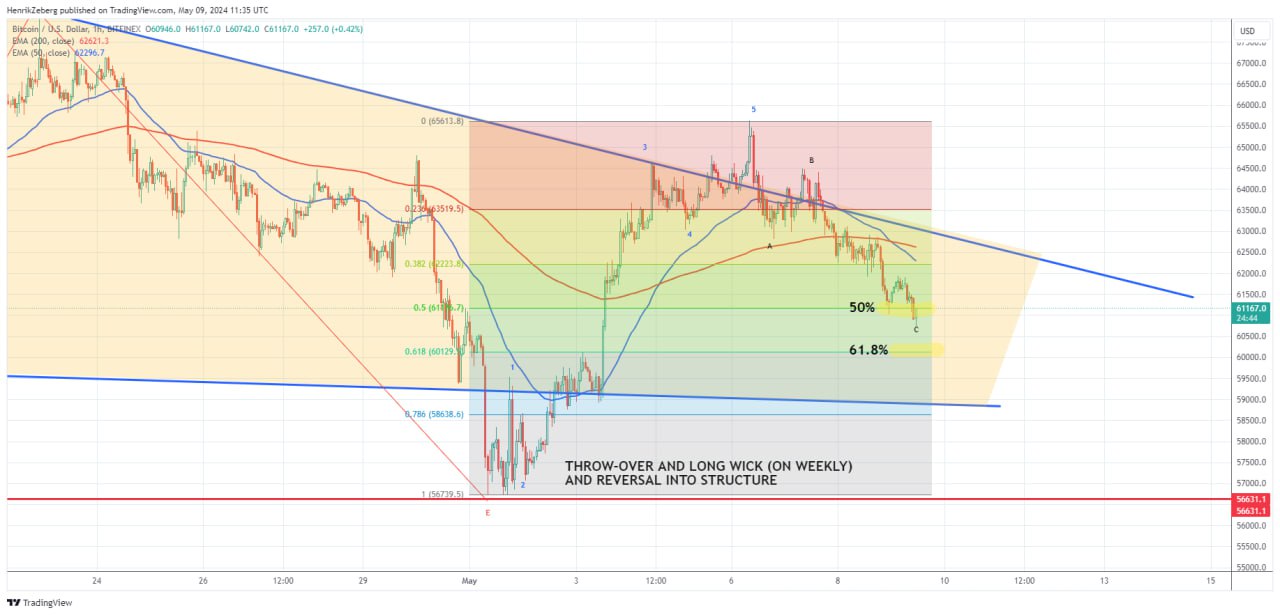Bitcoin
Bitcoin vs. Ethereum. Bitcoin and Ethereum are often compared… | by Blockchain.com | @blockchain | Jan, 2023
Published
1 year agoon
By
admin
Holding the number one and two spots for overall market cap in cryptocurrency, Bitcoin and Ethereum are often compared against each other.
There’s an ongoing debate over which cryptocurrency is better, but focusing on the individual tokens is only part of what makes Bitcoin and Ethereum different–and incredible.
The Bitcoin and Ethereum blockchains were created for different purposes, so it might be more useful to understand what makes each unique, what makes them different, and what that means for you.
What is Bitcoin?
A quick note on capitalization: Bitcoin with an uppercase B refers to the blockchain network and protocol, while bitcoin with a lowercase b refers to the cryptocurrency that is used on the Bitcoin network. BTC also refers to the bitcoin token.
As a blockchain protocol, Bitcoin acts as a settlement system that validates and records transactions between users on the network. The Bitcoin protocol is responsible for generating new blocks and working with miners to mint new BTC, while distributing copies of the ledger across all nodes (computers that verify transactions).
As a cryptocurrency, bitcoin is a peer-to-peer digital cash system, intended to be used as an alternative to traditional fiat currency like the US Dollar. Since BTC has a finite supply and takes work to create (more BTC can’t just be issued at any time), it’s often compared to gold.
BTC is the only token on the Bitcoin network, and is created through mining. BTC is also used to pay transaction fees to miners when they generate new blocks, and can be used as a medium of exchange or long-term store of value.
Learn more in Bitcoin, Explained
Ethereum was created to act as a decentralized world computer that uses smart contracts and allows developers to build on top of the core blockchain.
Ethereum has been the leading blockchain when it comes to DeFi, with many of the biggest dApps, DAOs and DEXs built on it, creating smaller cryptocurrency economies within the Ethereum ecosystem.
ETH is the native token of the Ethereum network, used for securing the network through staking, paying for transaction fees (called gas fees) and for voting on network improvements.
Ethereum utilizes a Proof of Stake consensus mechanism, allowing the network to use less energy while processing more transactions per second. Some blockchains built using Layer 2 or sidechain systems have even greater processing capabilities, which can be used for things like faster payments and blockchain gaming.
This kind of versatility is what Ethereum was built for, and ongoing improvements to the network could create even more opportunities for DeFi projects.
Learn more in Ethereum, Explained
Comparing Bitcoin and Ethereum
PoS vs PoW
Ethereum recently moved to a Proof of Stake consensus mechanism in “The Merge,” a change that has major implications for the blockchain and the ETH token.
Bitcoin has always operated on a Proof of Work consensus mechanism, and since it’s such a core part of Bitcoin’s monetary policy, this will likely never change.
Bitcoin has a hard-capped supply of 21,000,000 BTC, and Proof of Work (mining) is how new bitcoins are created. There is an infinite supply of ETH available, and now that Ethereum is using Proof of Stake they no longer utilize miners, but rather validators.
A validator is a staking participant who has staked at least 32 ETH and they earn rewards for staking their ETH. Bitcoin, using Proof of Work, also has validators, but users can become validators at any time, they don’t receive rewards for validating transactions, and there are already thousands of Bitcoin validator nodes in operation.
Almost anyone can run a Bitcoin node, since the code is open-source and there’s no token threshold, which increases decentralization as Bitcoin grows. Ethereum’s staking requirement of 32 ETH is cost prohibitive to most users, and the incentive of staking rewards has resulted in five corporations acting as the largest validators, holding the most staked ETH and collecting the most rewards.
This is because validators with more staked ETH are more likely to win rewards, and this has resulted in some criticism that moving to Proof of Stake means that Ethereum is not as decentralized as Bitcoin, since Bitcoin validator nodes are run independently and are not reliant on staking and earning rewards.
That being said, the Ethereum network can process more transactions per second than the Bitcoin network, and is less energy intensive. While the energy cost of Bitcoin’s PoW system is higher than other PoS systems, that cost is critical to the security of the Bitcoin network, as it makes matching the computing power of the hash rate nearly impossible due to cost.
Decentralization
A major point of contention in the Ethereum vs. Bitcoin debate is that of decentralization.
One of Bitcoin’s biggest strengths is that it is truly decentralized; it operates outside of any corporation, nonprofit or governmental organizations, and even Layer 2 solutions for Bitcoin don’t have an effect on the operation of the Bitcoin network or value of BTC itself.
Ethereum has multiple groups involved with managing and developing the network that hold large amounts of ETH. ETH is used for voting decisions on network improvements, and the more ETH a user holds, the greater their voting rights (more ETH = more power).
Basically, this means that a small group of users that hold a majority of the staked ETH have more authority in the Ethereum ecosystem, something many critics consider to be a degradation of decentralization.
Scalability
One of the most pointed criticisms of Bitcoin is that of scalability. How will Bitcoin be able to match the processing speed and functionality of Ethereum when it comes to enabling DeFi?
Ethereum was built to be built upon, and it allows smart contracts to function while also offering developers the ability to increase scale through Layer 2 solutions. One way to think of Ethereum is as a software, like the Apple iOS, which allows other apps to be used on it.
This is how decentralized exchanges, gaming platforms and other Web3 tools are built on Ethereum, and ETH is the cryptocurrency that powers it all. The Ethereum blockchain is even being used in fields like healthcare to improve security and transparency.
However, there are also scaling solutions for the Bitcoin network, the most popular being the Lightning Network. Lightning is a Layer 2 network solution that uses smart contracts to allow for faster bitcoin payments, while retaining the security of the main Bitcoin network.
Adoption and development of the Lightning Network is increasing, but there are some issues with it, such as additional fees, stuck payments and the possibility of scams. Regulation around the Lightning Network is uncertain, but this is true of most DeFi tools.
Bitcoin or Ethereum: Who wins?
Despite their differences, both Ethereum and Bitcoin offer solutions that would have been impossible just twenty years ago. They were built for different purposes, but those differences are actually beneficial.
With Bitcoin, you have a long-term store of value thanks to the Proof of Work consensus mechanism and limited supply, and BTC can be used as a medium of exchange, especially as payment solutions like the Lightning Network develop.
Using Ethereum, you can access tons of DeFi tools that allow you to trade, swap and even borrow assets using crypto. The biggest Web3 projects live on Ethereum too, so that opens up things like NFTs and blockchain gaming.
As a crypto user, you’re the winner.
You have the choice of using Bitcoin and Ethereum, either separately or together. Choosing to buy BTC or ETH really just depends on your needs and goals, and like anything you’d buy, you have to do your own research to figure out what that means for you.
You can buy BTC and ETH at Blockchain.com, but first you’ll need a Wallet. Blockchain.com provides crypto wallets to millions of people, and allows you to self-custody your crypto so you have full control of your assets.
Source link
You may like


Insight Into The Timing And Factors


Bitcoin About To ‘Blow Higher’ Despite This Week’s Pullback, According to Glassnode Co-Founders – Here’s Why


Azuro and Chiliz Working Together to Boost Adoption of Onchain Sport Prediction Markets – Blockchain News, Opinion, TV and Jobs


Robinhood Bleeds 164 Million Dogecoin


AIGOLD Goes Live, Introducing the First Gold Backed Crypto Project – Blockchain News, Opinion, TV and Jobs


Analyst Benjamin Cowen Warns Ethereum ‘Still Facing Headwinds,’ Says ETH Will Only Go Up if Bitcoin Does This

The Bitcoin price has experienced heightened volatility over the past week. After recovering from a low of $56,500, the largest cryptocurrency in the market surged to $65,500 within four days. However, it has since retraced some of its gains and is currently testing the $61,000 support level.
Despite this volatility and the absence of strong bullish momentum, venture capital firm Pantera Capital remains optimistic about the future of BTC’s price, citing the recent Halving event as a significant factor.
Pantera Capital Projects $117,000 Price Target By 2025
In a recent investor letter, Pantera Capital revealed its Bitcoin Halving rallies model, which predicts a bottoming out of the BTC price followed by a rise through the Halving rally.
Based on the average duration of previous rallies, the firm forecasts that BTC’s price will peak at $117,000 in August 2025. The average total duration of this cycle, encompassing pre- and post-Halving rallies, has historically been around 2.6 years, with symmetry observed across cycles.
Related Reading
Pantera Capital highlights the relationship between Halving events and BTC’s price. The firm asserts that if the demand for new Bitcoin remains constant while the supply of new Bitcoin is reduced by half, it will create upward pressure on the price.
The anticipation of a price increase has also historically driven increased demand for Bitcoin leading up to Halving events. However, Pantera Capital acknowledges that the impact of each subsequent Halving on price may diminish as the reduction in the supply of new Bitcoin from previous Halvings becomes less significant.
Moreover, the firm notes that, on average, the Pantera Bitcoin Fund has nearly doubled in value for eleven years. Based on this historical performance, Pantera Capital envisions a scenario in which the price of Bitcoin reaches $117,000 by 2025.
Bullish Bitcoin Price Predictions
Renowned crypto analyst Titan of Crypto has recently taken to social media platform X (formerly Twitter) to share bullish predictions for the Bitcoin price. With forecasts ranging from $75,000 to $110,000, Titan of Crypto highlights various factors and patterns that could potentially drive BTC’s growth.
According to Titan of Crypto, a price rise to $110,000 for Bitcoin is “programmed.” While the analyst did not elaborate on the specifics of this programming, it suggests a strong conviction in BTC’s potential to reach that level.
Titan of Crypto also identifies a current head-and-shoulders pattern in the Bitcoin price chart. If this pattern holds, the analyst suggests that BTC could rise to the $75,000 mark. If confirmed, this pattern could signify a bullish trend reversal and further support the projection of Bitcoin reaching higher price levels.
Related Reading
The analyst also highlighted $61,500 as a critical point to monitor due to the possibility of “panic selling.” The analyst suggests many market participants might react to this level, potentially increasing selling pressure.
Lastly, based on his analysis, the analyst suggests a conservative price prediction of $108,000. However, Titan of Crypto believes that BTC’s price may exceed this projection, indicating a more optimistic outlook.
Featured image from Shutterstock, chart from TradingView.com
Source link
Bitcoin
Bitcoin About To ‘Blow Higher’ Despite This Week’s Pullback, According to Glassnode Co-Founders – Here’s Why
Published
1 week agoon
May 9, 2024By
admin
The founders of crypto analytics platform Glassnode are predicting that Bitcoin (BTC) will soon soar even higher after being up 7% in the last week.
In a new thread, the co-founders of Glassnode, who go by the handle Negentropic on the social media platform X, tell their 62,900 followers that key indicators suggest Bitcoin is gearing up from a massive breakout.
The analysts say Bitcoin appears to be forming a bullish pennant pattern. They also suggest that Bitcoin is correcting to a Fibonacci retracement level, in the low $60,000 range, which often predicts a continuation of an upward trend.
“BTC still looks like it is about to blow higher! Last week’s candle was a reversal candle – a hammer with a long wick. Price moved back into the pennant structure. This candle still dominates the structure. This week’s pullback, hence, seems like a healthy correction before higher. Corrections often pull back either 50% or 61.8% of the previous impulse move.”

Looking at their chart, the analysts suggest that Bitcoin has or is about to complete a three-wave ABC correction. The Elliott Wave theory states that a bullish asset often witnesses a fresh leg up after an ABC correction of three wave impulses.
The analysts believe Bitcoin could break through the $85,000 level before the start of summer, which officially begins on June 20th.
“BTC is currently in the process of breaking the trendline of pennant and the 50-day SMA (simple moving average). When the level of $65,000-$66,000 is broken, BTC will move on to first $73,500, then $76,500, and chances are that we see $85,200 before the summer.”
Bitcoin is trading for $62,016 at time of writing, down slightly in the last 24 hours.
Don’t Miss a Beat – Subscribe to get email alerts delivered directly to your inbox
Check Price Action
Follow us on X, Facebook and Telegram
Surf The Daily Hodl Mix
 

Disclaimer: Opinions expressed at The Daily Hodl are not investment advice. Investors should do their due diligence before making any high-risk investments in Bitcoin, cryptocurrency or digital assets. Please be advised that your transfers and trades are at your own risk, and any losses you may incur are your responsibility. The Daily Hodl does not recommend the buying or selling of any cryptocurrencies or digital assets, nor is The Daily Hodl an investment advisor. Please note that The Daily Hodl participates in affiliate marketing.
Featured Image: Shutterstock/Warm_Tail
Source link
Bitcoin
Analyst Benjamin Cowen Warns Ethereum ‘Still Facing Headwinds,’ Says ETH Will Only Go Up if Bitcoin Does This
Published
2 weeks agoon
May 9, 2024By
admin
The widely followed analyst Benjamin Cowen is saying that Ethereum (ETH) is at risk of facing more downside over the coming months.
In a new video, Cowen tells his 801,000 YouTube subscribers that monetary policy is likely to negatively affect Ethereum.
“I think that ETH/USD is still facing some headwinds here, especially following the potential rejection of the spot exchange-traded fund (ETF)…
…I think the impact that people are going to feel is just from tighter monetary policy. They’re going to blame it on the spot ETF and they’re going to capitulate potentially into that.”
According to Cowen, the Ethereum could go up on one condition.
“If ETH goes up from here, it would only be due to Bitcoin going up a lot more.”
The widely followed analyst says that the Ethereum/Bitcoin (ETH/BTC) pair, on the other hand, is likely to keep falling under most circumstances based on history.
“So if Ethereum goes up, Ethereum/Bitcoin is probably going to keep going down. If Bitcoin goes sideways, Ethereum/Bitcoin is going to keep going down in my opinion. And if Bitcoin goes down, Ethereum/Bitcoin probably goes down because Bitcoin has been doing all s of things since 2022 began. In eight of 10 quarters, Ethereum/Bitcoin has gone down whether Bitcoin went up, down or sideways. Ethereum/Bitcoin generally went down.”
ETH is trading at $3,002 at time of writing.
Don’t Miss a Beat – Subscribe to get email alerts delivered directly to your inbox
Check Price Action
Follow us on X, Facebook and Telegram
Surf The Daily Hodl Mix
 

Disclaimer: Opinions expressed at The Daily Hodl are not investment advice. Investors should do their due diligence before making any high-risk investments in Bitcoin, cryptocurrency or digital assets. Please be advised that your transfers and trades are at your own risk, and any losses you may incur are your responsibility. The Daily Hodl does not recommend the buying or selling of any cryptocurrencies or digital assets, nor is The Daily Hodl an investment advisor. Please note that The Daily Hodl participates in affiliate marketing.
Generated Image: DALLE3
Source link

Insight Into The Timing And Factors

Bitcoin About To ‘Blow Higher’ Despite This Week’s Pullback, According to Glassnode Co-Founders – Here’s Why

Azuro and Chiliz Working Together to Boost Adoption of Onchain Sport Prediction Markets – Blockchain News, Opinion, TV and Jobs

Robinhood Bleeds 164 Million Dogecoin

AIGOLD Goes Live, Introducing the First Gold Backed Crypto Project – Blockchain News, Opinion, TV and Jobs

Analyst Benjamin Cowen Warns Ethereum ‘Still Facing Headwinds,’ Says ETH Will Only Go Up if Bitcoin Does This

Tron Price Prediction: TRX Outperforms Bitcoin, Can It Hit $0.132?

Ethereum-Based Altcoin Leads Real-World Assets Sector in Development Activity, According to Santiment

Here’s Why This Analyst Is Predicting A Rise To $360

Hackers With $182,000,000 Stolen From Poloniex Starts Moving Funds to Tornado Cash

Cardano Faces Make-Or-Break Price Level For Bullish Revival

A Premier Crypto Exchange Tailored for Seasoned Traders – Blockchain News, Opinion, TV and Jobs

Crypto Whale Withdraws $75.8 Million in USDC From Coinbase To Invest In Ethereum’s Biggest Presale – Blockchain News, Opinion, TV and Jobs

CFTC Chair Says ‘Another Cycle of Enforcement Actions’ Coming As Crypto Enters New Phase of Asset Appreciation

Spectral Labs Joins Hugging Face’s ESP Program to advance the Onchain x Open-Source AI Community – Blockchain News, Opinion, TV and Jobs

Bitcoin Dropped Below 2017 All-Time-High but Could Sellers be Getting Exhausted? – Blockchain News, Opinion, TV and Jobs

What does the Coinbase Premium Gap Tell us about Investor Activity? – Blockchain News, Opinion, TV and Jobs
BNM DAO Token Airdrop

NFT Sector Keeps Developing – Number of Unique Ethereum NFT Traders Surged 276% in 2022 – Blockchain News, Opinion, TV and Jobs
New Minting Services

Block News Media Live Stream
A String of 200 ‘Sleeping Bitcoins’ From 2010 Worth $4.27 Million Moved on Friday

SEC’s Chairman Gensler Takes Aggressive Stance on Tokens – Blockchain News, Opinion, TV and Jobs

Friends or Enemies? – Blockchain News, Opinion, TV and Jobs

Enjoy frictionless crypto purchases with Apple Pay and Google Pay | by Jim | @blockchain | Jun, 2022

Block News Media Live Stream

How Web3 can prevent Hollywood strikes

Block News Media Live Stream

XRP Explodes With 1,300% Surge In Trading Volume As crypto Exchanges Jump On Board

Block News Media Live Stream
Trending

 Altcoins2 years ago
Altcoins2 years agoBitcoin Dropped Below 2017 All-Time-High but Could Sellers be Getting Exhausted? – Blockchain News, Opinion, TV and Jobs

 Binance2 years ago
Binance2 years agoWhat does the Coinbase Premium Gap Tell us about Investor Activity? – Blockchain News, Opinion, TV and Jobs
- Uncategorized2 years ago
BNM DAO Token Airdrop

 BTC1 year ago
BTC1 year agoNFT Sector Keeps Developing – Number of Unique Ethereum NFT Traders Surged 276% in 2022 – Blockchain News, Opinion, TV and Jobs
- Uncategorized3 years ago
New Minting Services

 Video2 years ago
Video2 years agoBlock News Media Live Stream

 Bitcoin miners2 years ago
Bitcoin miners2 years agoA String of 200 ‘Sleeping Bitcoins’ From 2010 Worth $4.27 Million Moved on Friday

 Bitcoin1 year ago
Bitcoin1 year agoSEC’s Chairman Gensler Takes Aggressive Stance on Tokens – Blockchain News, Opinion, TV and Jobs

